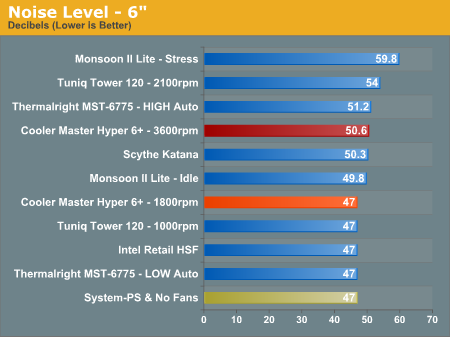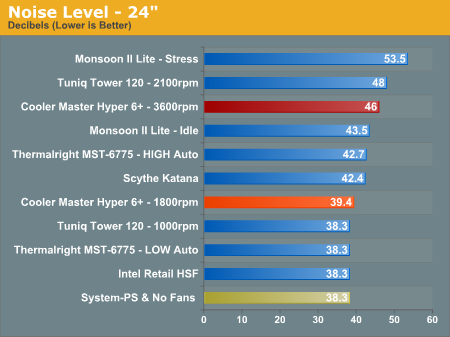Cooler Master Hyper 6+: Universal Heatpipe Tower
by Wesley Fink on February 14, 2007 12:02 AM EST- Posted in
- Cases/Cooling/PSUs
Noise
For many enthusiasts the goal in upgrading cooling is maximum stable overclock, and they will live with the inconvenience of a louder system. For other users silence is the most important factor, and these users will forgo maximum overclocking if this increase system noise levels. In general the Hyper 6+ can be considered very quiet, which is certainly an improvement from the early models with the louder fan - at least where noise is concerned.
We could not create operating conditions that reliably forced highest speed on the 100mm fan, so we attached a Zalman fan controller and dialed in the highest speed to create that condition. For that reason the stress noise measurements should be considered the worst case measurements - noise that you will not likely ever hear with this cooler.
There are virtually no power supplies that do not have a fan. While Zalman and a few others do make a few expensive fanless power supplies, we have not seen a fanless unit larger than 500W, or one that would be used for seriously overclocking a system. With that in mind the noise level of the system with all fans turned off except the power supply was measured. The power supply used for the cooling test bed was the OCZ PowerStream 520, which is one of the quieter of the high performance power supplies. The noise level of the power supply was 38.3dB from 24" (61cm) and 47dB from 6" (152mm). The measured noise level of the test room is 36.4dB, which would be considered a relatively quiet room with a noise floor slightly below the OCZ PowerStream 520 PSU.


Measured noise levels in this chart should be considered worst case. Measurements were taken with an open side of a mid tower case 6" from the open HSF and 24" from the open HSF. Real world would be a completely closed case with a further reduction in noise.
The noise measurements for the Cooler Master Hyper 6+ were definitely on the quiet side of tested coolers. The 100mm cooling fan on the Cooler Master is extremely quiet at low speeds, within 1 dB or below the noise floor of the test system. It is also among the quietest coolers at higher speeds, and comparable to other high-end units at maximum speed. Considering the Hyper 6+ fan has to work harder at 3600 rpm, it certainly remains a quiet fan. It is also rare than the fan even approaches high speed in day-to-day operation.
The only small complaint we have is that the excellent fan included in the kit is a non-standard 100mm. Buyers would have had a wider range of noise control and performance options had Cooler Master chosen a standard fan size like 120mm or 92mm.
For many enthusiasts the goal in upgrading cooling is maximum stable overclock, and they will live with the inconvenience of a louder system. For other users silence is the most important factor, and these users will forgo maximum overclocking if this increase system noise levels. In general the Hyper 6+ can be considered very quiet, which is certainly an improvement from the early models with the louder fan - at least where noise is concerned.
We could not create operating conditions that reliably forced highest speed on the 100mm fan, so we attached a Zalman fan controller and dialed in the highest speed to create that condition. For that reason the stress noise measurements should be considered the worst case measurements - noise that you will not likely ever hear with this cooler.
There are virtually no power supplies that do not have a fan. While Zalman and a few others do make a few expensive fanless power supplies, we have not seen a fanless unit larger than 500W, or one that would be used for seriously overclocking a system. With that in mind the noise level of the system with all fans turned off except the power supply was measured. The power supply used for the cooling test bed was the OCZ PowerStream 520, which is one of the quieter of the high performance power supplies. The noise level of the power supply was 38.3dB from 24" (61cm) and 47dB from 6" (152mm). The measured noise level of the test room is 36.4dB, which would be considered a relatively quiet room with a noise floor slightly below the OCZ PowerStream 520 PSU.


Measured noise levels in this chart should be considered worst case. Measurements were taken with an open side of a mid tower case 6" from the open HSF and 24" from the open HSF. Real world would be a completely closed case with a further reduction in noise.
The noise measurements for the Cooler Master Hyper 6+ were definitely on the quiet side of tested coolers. The 100mm cooling fan on the Cooler Master is extremely quiet at low speeds, within 1 dB or below the noise floor of the test system. It is also among the quietest coolers at higher speeds, and comparable to other high-end units at maximum speed. Considering the Hyper 6+ fan has to work harder at 3600 rpm, it certainly remains a quiet fan. It is also rare than the fan even approaches high speed in day-to-day operation.
The only small complaint we have is that the excellent fan included in the kit is a non-standard 100mm. Buyers would have had a wider range of noise control and performance options had Cooler Master chosen a standard fan size like 120mm or 92mm.










25 Comments
View All Comments
Samus - Wednesday, February 14, 2007 - link
What a waste of metal, what are the odd's that someone is going to buy this $50 cooler to overclock their AthlonXP. Do people even have AthlonXP's anymore? They've been discontinued for years.LoneWolf15 - Thursday, February 15, 2007 - link
If you've got an Athlon XP-M, it really might be fun to try this one out. My XP-M 2500+ made 2.4GHz on air (Thermalright cooler) when I had it, which is even now competetive for a lot of apps. The advantage is that an XP owner can buy this cooler, and then continue to use it when they step up to a new CPU/mainboard. It adds a selling point to this cooler that I'm sure some will appreciate.Shinei - Wednesday, February 14, 2007 - link
To be honest, I would. I still run an Athlon XP, and it's cheaper to pay $50 for a new HSF that might buy me a couple extra MHz than $800 on a total refit (CPU, board, RAM, video card). Unless, of course, you're offering to buy me a new computer, in which case, I accept! B)Macuser89 - Wednesday, February 14, 2007 - link
I wish you would compare a similar Zalmen cooler. Zalmen are pretty good, and i just wonder how they compare to others.Wesley Fink - Wednesday, February 14, 2007 - link
We have the top-of-the-line Zalman 9700 in the lab for review.strikeback03 - Wednesday, February 14, 2007 - link
Any chance of testing a 9500 as well? I don't think a 9700 will fit beneath my PSU.And I think it might have been mentioned in the Tuniq review, but was all temperature testing done with it at high speed? Would temps be affected if it were slowed down the same way the PWM-controlled fans slow down?
Wesley Fink - Wednesday, February 14, 2007 - link
The Hyper 6+ has a 4-pin fan connection that can control fan speed. Temperature testing was done at default speed, although we did manually force highest speed to see if it made any difference in OC. It really did not improve OC performance. For noise testing we manually forced highest speed and reported both low speed (1800 RPM) and high speed (3600 RPM) results.Since the kit auto controls fan speed on a 4-pin header we thought this was the fairest way to test performance. For noise we were concerned with the loudest you could possibly encounter with this cooler, which is why we manually forced highest speed.
tuteja1986 - Wednesday, February 14, 2007 - link
Can't someone make a much better air cooler than Tuniq Tower 120 for overclocking needs.LoneWolf15 - Wednesday, February 14, 2007 - link
If you ever buy a Tuniq Tower, I think you'll find that it cools so well, that improving upon it without liquid or a TEC would be extremely difficult.Up until recently I was using a Swiftech MCX-64V that I thought was a pretty darn good cooler, albeit a little older, with a low-noise Delta 80mm fan.
The Tuniq beats it by 8-10C when idle, and by 10-15C under load in my system (Athlon 64 X2 4800+). And it isn't any louder (it may indeed be quieter, but my case fans overshadow the noise it makes anyway). About the only thing that I think Tuniq could try is lapping the contact surface better (on an IHS-based chip with AS5 goop I doubt this will help much) or adding additional heatpipes (i.e. going from six to eight), and I'm not sure that will do that much good either. The Tuniq is already amazing at how cool it can keep a CPU under load, a good indicator of its performance in overclocked situations (provided you have the right CPU/mainboard/ram/power supply to go with, of course). It also has the advantage of taking a 120mm fan, as opposed to the good, but proprietary Zalman, or the 100mm of the Coolermaster, allowing you to select from a wide range of fans to favor hardcore cooling, or near-silent operation.
I'm curious (no disrespect intended) --how do you think someone would go about making a better air cooler than the Tuniq?
flipmode - Thursday, February 15, 2007 - link
Start with the Tuniq and the make one that's lighter, with an even quieter fan, and not so large, with a better mounting system. That would be better in my book. Better doesn't always have to apply to cooling power - though I think that's probably what you were talking about.